Mysteries in the Office Supply Aisle: Paper Doll Plays Detective
The world of professional organizing isn’t likely to become a mystery classic. I don’t anticipate Decluttering on the Orient Express, The Maltese Filing Cabinet or The Thin Man’s Disturbing Pile of Paper Clutter to become New York Times best-sellers. And certainly, I doubt anyone’s ever thought of writing a mystery about office supplies. Until now.
This past weekend was my state’s tax-free holiday weekend. A beloved friend and former client (we’ll call her Paper Sara) and I were planning to get together for dinner, and arranged to meet at a local big box office supply store. It should be no surprise that Paper Doll loves school supplies. After all, what are school supplies except office supplies for those whose office is a cubby or locker?
Speaking of lockers, when Paper Sara found me, I was transfixed by the metal pop-up LockerMate locker shelves near the front of the store.
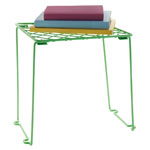
I’d gotten one open, but couldn’t quite close it. When I mused aloud that I suspected it must operate like an ironing board, Paper Sara played Holmes to my Watson and managed to break it down. (Paper Doll only claims expertise in organizing; mechanical engineering is a different course altogether).
We discussed our envy of kids these days, at least in relation to school supply options. I clearly recall Paper Mommy having to schlep me to a nearby lumber yard to have a splintery wooden board cut to the guidance department’s specifications, and even then, the balance of the board inside the locker was precarious. Similarly, I remember using brown paper Wegman‘s grocery store bags as book covers; students now have their pick of stretchy Spandex book covers 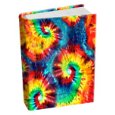 that seem more like fashionable bathing suits than ways to protect 9th grade Social Studies texts from spilled lunch and slushy snow.
that seem more like fashionable bathing suits than ways to protect 9th grade Social Studies texts from spilled lunch and slushy snow.
Paper Sara and I were gleeful at the prospect of marching up and down every aisle to “take inventory” and view all of the best in school and office supplies. I was pleased to share my advice and counsel on products I’d researched for my blog posts, and we spent some quality time unboxing (non-shrink-wrapped) products to examine them. We Tsk-Tsked over store-brand faux-Lucite desk accessories that squeaked, the very type against which I’d contrasted the non-squeaking Pendaflex PileSmart Organizer Tray we talked about a few weeks ago.
As my flair for the dramatic didn’t extend to opening shrink-wrapped packaging, I had to limit my fun to acting out the benefits of Smead’s Easy Grip Pocket, which I blogged about after this year’s NAPO conference. It’s just not the same, trying to illustrate the seemingly magic “grippy” powers without a brick or heavy item inside, or even achieving true tactile contact with the non-slip grip. Nonetheless, Paper Sara appreciated the concept and was eager to acquire one for taking her Cleveland, Tennessee Sara’s Hallmark Store financial paperwork to her accountant.
We wondered, not for the first time, why standard hanging folders were invented in such a horrible green shade. (That’s a mystery that only Esselte, the former Oxford Pendaflex Company, inventors of hanging folders, know for sure.) We marveled at anti-microbial (“Fights Mold, Mildew and Odors”!) file folders and those that fight paper cuts.
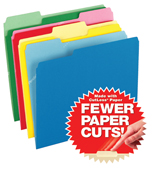
Next, we visited the Sharpie center and shared our mutual compulsion to organize everything that visiting children (and I’m sure, a few grownups) had put asunder. We straightened out the colors into their pre-labeled cubbies, separated the traditional Sharpies from the newer, snazzier Sharpie pens and markers, and tested the loveliness of colors, like Berry vs. Boysenberry and Coconut vs. Stingray. We sought, in vain, to tidy away one stray Sharpie marker in Pomegranate, which lacked a home altogether. (Readers: Don’t think we weren’t tempted to buy it, just to ensure a more organized display!)
At this point in a real mystery story, there would be a seemingly tangentially-related flashback, so Paper Sara and I shared our back-to-school shopping recollections.
It will surprise nobody that Paper Doll not only liked school, but particularly back-to-school supply shopping. Paper Mommy was happy to relinquish the duties to me, and by third grade, I’d have spent much of August writing and rewriting the ultimate school supply list. If Paper Mommy wondered why I felt compelled to have a new compass and protractor each year, she kept it to herself, happy that her weird little child could get so much joy from college-ruled paper and so much intellectual abandon out of an interior debate between Trapper Keepers vs. standard two-pocket folders.
(Speaking of which, did you know that people in the Midwest and Western U.S. have their own school supply lingo? From fellow professional organizers Krista Colvin and Brandie Kajino, I recently learned that while we Buffalonians had quotidian two-pocket folders, our cohorts to the left of us had Pee Chees!)
Flash-forward to the present day. Although Paper Doll likes to consider herself an expert in office and school supplies, our anthropological dig through the store turned me into Paper Poirot. First, we located an unusual treasure in the same aisle as index cards, from the Pendaflex (Esselte) Oxford line. At first, they appeared to be index cards as well, but the slightly rounded corners set them apart from traditional “take notes for your book report” resource. It was a 75 pack of 3″ x 5″ Assorted Book Mark Cards.
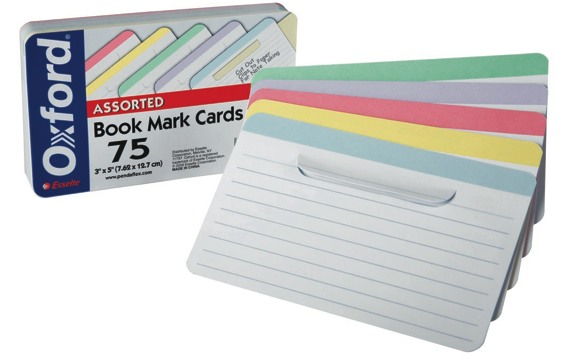
I immediately saw the appeal of the cards, which are designed to have multiple benefits for students and other researchers:
- As bookmarks, they specify the page you wish to mark.
- As lined index cards, they allow you to write copious notes to reference what you’ve found on the page. Students, from elementary kids to PhD candidates would find these dependable ways to capture thoughts and match them to the primary source material.
- As tabbed cards, they’re more likely to stay in place than glossy bookmarks. Anyone who has ever dropped a stack of textbooks with numerous pages marked by standard index cards, napkins or loose papers knows that method can be a recipe for chaos.
- As a tabbed card, they prevent any concern about page-damaging adhesive residue, such as we discussed a few weeks ago in Organizing With Post-it Notes: Revenge of the Floozies.
- Coming in assorted colors, the cards allow the user to color-code notes and references.
- The colorful top lines of the tabbed cards allow the user to label and categorize.
Book Mark Cards obviously provide the greatest boon to academic reading, but could easily be adapted for use in cookbooks (especially those with poor indexing), to aid in quickly finding a favorite recipe for a specific occasion and making applicable notes for future reference. Had these cards been available when I was a television program director, it would have made the comparative data in the cramped Nielsen ratings books much easier to track.
I was so impressed with this simple, elegant solution to a problem I’d long encountered that I bought it on the spot. However, when I returned to my computer, I was flummoxed. There was nary a word of reference to this product on the Pendaflex website, nor on any office supply store websites, nor anywhere, it seemed, on the internet. The Oxford Book Mark Cards were a ghost!
Never to be dissuaded from following the scent of a good office supply mystery, I searched the product’s UPC code, first on the web in general, and then in the UPC Database (usually a treasure trove of tracking information on intriguing, if surreptitious, product behavior). Nada!
My Google-fu had failed me. At this point, I called in professional organizer reinforcements on Facebook and Twitter. Many theories abounded. Was it too new a product to be listed anywhere? Had it been discontinued? Perhaps my city was a test market? Was I in some crazy Matrix/Inception/FightClub alternate reality?
(The first rule of Oxford Book Mark Cards is you don’t talk about Oxford Book Mark Cards!)
Finally, when organizing product maven Jeri Dansky declared that she, too, was giving up, I knew I’d have to go to the source, and first thing Monday morning, I placed calls and sent emails to various Esselte VIPs. The fabulous Meryl Altuch, Esselte’s Director of Product Marketing, solved the mystery. (She even managed to provide the lovely photo you see above, obviating further failed attempts on my part to take a close-up digital photo without the flash obscuring the words on the packaging. Yes, Paper Doll needs an official photographer!).
The resolution to the mystery of the ghost product? Oxford Book Mark Cards are currently only available in Office Depot stores. It’s a bit of a proprietary product for them, but it doesn’t seem that Office Depot sells them online. So, if the Book Mark Cards meet your little (or full-size) researcher’s needs, you’ll have to visit one of the 1100 Office Depot stores near you.
A less satisfactory alternative for those unable to reach an Office Depot is a competing product from Mead (the Trapper Keeper people!). The Mead Bookmark Index Cards are available from Amazon, in packs of 70 instead of 75, but only in sets of 12! Hopefully, Office Depot will start making their cards available via online ordering in the future.
Every mystery story seems to have a primary puzzle, a grand A storyline, and a smaller B-story. From our shopping trip, the B-story came in the form of itty-bitty index cards. Certainly we’ve all seen traditional 3″ x 5″ cards, the larger 4″ by 6″ cards and even 5″ x 8″. (Sidebar for students heading back to school and hoping to impress either their biology or history teachers: Carl Linnaeus, the father of modern taxonomy, invented the index card.)
But what are we to make of the Oxford Half-Size Index Cards? They measure 3″ x 2 1/2″ and come in both color
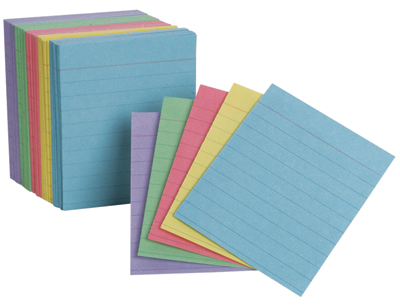
and standard white 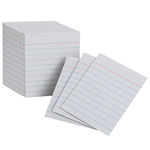 , and are lined like traditional index cards.
, and are lined like traditional index cards.
They’re cute and sometimes the appeal of office supplies can be chalked up to aesthetics. But Paper Doll is curious as to what students (or anyone) might use these narrower index cards to do that they might not do with standard cards. Is there a compelling reason one might want smaller index cards? Is there an educational experience for which smaller cards are superior? (For example, is it easier to learn kanji  when there’s less white space on the flashcard?)
when there’s less white space on the flashcard?)
The solution(s) to this mystery, I leave for you readers to detect. Please submit your ideas, practical and silly, sublime or ridiculous. What might you do with a half-size index card?




Follow Me